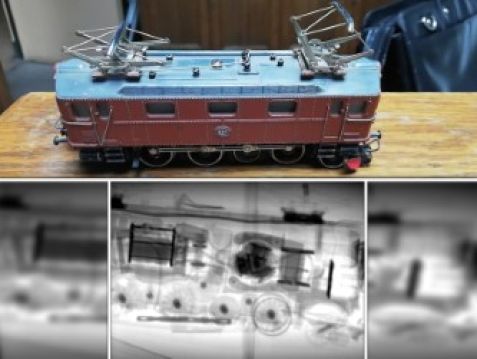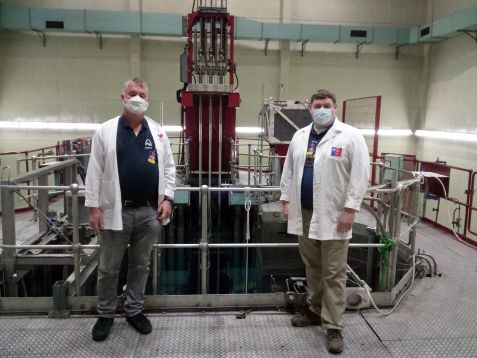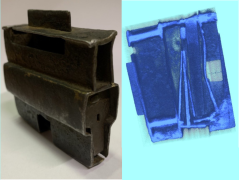MLZ is a cooperation between:
 > Technische Universität München
> Technische Universität München > Helmholtz-Zentrum Hereon
> Helmholtz-Zentrum Hereon
 > Forschungszentrum Jülich
> Forschungszentrum Jülich
MLZ is a member of:
 > LENS
> LENS > ERF-AISBL
> ERF-AISBL
MLZ on social media:

MLZ (eng)
Lichtenbergstr.1
85748 Garching
25.03.2023
Garching neutron tomography facility travels around the world
The International Atomic Energy Agency has commissioned Dr. Burkhard Schillinger of the Heinz Maier-Leibnitz Center (MLZ) to test low-power neutron sources in Argentina and Chile. He traveled to South America with a smaller, transportable version of the neutron tomography facility from Garching. After only two days, the facility was ready and successfully delivered first test images.

Photo of the model railway locomotive and its recording by means of the mini-tomography equipment. © Eugenio Alejandro Vargas / CChEN
When objects are radiographed with neutrons, unique and precise images are produced. 3D images, so-called tomographies, can be generated from a large number of images taken from different viewing directions. Neutron sources produce the neutrons needed for this via nuclear fission. The neutrons generated by the research neutron source in Garching are already being used to examine objects. To test and improve this at other neutron sources, researchers at MLZ developed a transportable version of their neutron tomography facility.
“Evolution” of the mini-tomography facilities
The construction of the first mini facility for the VR-1 research reactor in Prague was led by Dr. Burkhard Schillinger, instrument scientist at the ANTARES radiography and tomography facility at MLZ – ‘Neutron imaging detector in handbag size’. This facility was built from aluminum parts, while the newer version comes from a 3D printer. Simon Sebold, Tobias Neuwirth and Tobias Jünger from MLZ had tinkered with the design. Finally, their colleague Jens Krüger adapted the original software of the ANTARES detectors to the small transportable system. “This makes the system easier to operate and gives us more options,” explains Burkhard Schillinger.

Burkhard Schillinger and Aaron Craft at the RECH-1 reactor in Chile, © Eugenio Alejandro Vargas / CChEN
Successful tests in Chile and Argentina
In Santiago de Chile, Burkhard Schillinger and Aaron Craft of Idaho National Lab, USA, set up the tomography facility in just two days, at the RECH-1 research reactor, built in 1974. For test measurements, they irradiated a model railroad locomotive with neutrons and generated 3D images from the results. Enthusiastic and motivated, the actual collaboration now begins: The technical elements are copied and a permanent experimental site is set up. Sufficient shielding against the beams must not be missing here. Schillinger says, “We’re confident that with the experience we’ve gained, we can get this done fairly quickly.”
The small RA-6 research reactor in Bariloche, Argentina, built in 1982, already had tomography equipment, but it was so outdated that it could no longer produce good images. To improve the facility, the VR-1 team from Prague helped. The Garching group built a new better adapted detector with tomography control, which the PhD student Jana Matouskova from Prague installed and put into operation during a research stay. Burkhard Schillinger lent a hand with the retrofit after a conference in Argentina: “I installed the new software,” explains the scientist. The team also succeeded in producing sharp and precise test images in Bariloche.
Why tomography equipment in particular?
The projects are about equipping aging, small research reactors with tomography facilities as a new application. Tomography uses the whole neutron beam, so even weaker neutron sources are sufficient for it. For experiments that use only a small part of the energy spectrum of the neutron beam, such smaller sources would be too weak. This is the case, for example, with neutron scattering experiments, “which is why people like to build tomography systems on older neutron sources and optimize them,” says Burkhard Schillinger.
In Chile and Argentina, the first researchers are now using the new tomography systems to examine their samples. In order to make the principle of their mini tomography system available to other research groups, Burkhard Schillinger’s team has written two scientific publications that will soon appear. One publication will describe the detailed set-up in Bariloche. In addition, the group has also already provided a website with the construction plans and software.
MLZ is a cooperation between:
 > Technische Universität München
> Technische Universität München > Helmholtz-Zentrum Hereon
> Helmholtz-Zentrum Hereon
 > Forschungszentrum Jülich
> Forschungszentrum Jülich
MLZ is a member of:
 > LENS
> LENS > ERF-AISBL
> ERF-AISBL
MLZ on social media:



